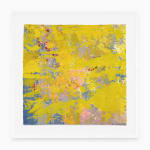Sam Gilliam
Further images
Gilliam's experimentations were radical; they contributed significantly to the diversification of the American art scene by demonstrating that abstraction could carry cultural and political resonance. His works from this period reflect an unbounded enthusiasm for the potential of color as a communicative tool. The depth and richness of his palette transcended mere aesthetics, speaking to a sensory and emotional experience that paralleled the era’s quest for racial and social justice. His abstract language became a visual counterpart to the Civil Rights Movement, as it sought to transcend the limitations of narrative art, offering instead a universal form that could evoke a collective human experience, beyond the specifics of race or creed. In this way, Gilliam's art became a space for contemplation and solidarity, reflective of a society in transition.
The present work completed in 1973 stands as a testament to Gilliam's mastery of his medium and his ability to infuse his work with layered meanings. The dominance of yellow—a color often associated with warmth, energy, and visibility—commands immediate attention and radiates an optimistic vitality. Yet, the complexity of the artwork is revealed through Gilliam’s nuanced use of hue and texture, where the interplay of muted blues, pinks, and hints of raw paper under the yellow suggests depth and dimension. The piece evokes an emotional response akin to the introspection and aspiration for a brighter future that characterized the era it was born in. ‘It’s Yellow’ thus becomes more than an object of visual intrigue; it embodies the spirit of its time, showcasing the power of abstract art to encapsulate and contribute to the cultural and social shifts of its day.
NOTES
This artwork is signed and dated in pencil ‘Sam Gilliam 73’ on the lower right side. It is also inscribed in pencil on the verso ‘It’s Yellow.’ This work is unique.
We extend our gratitude to Ms. Annie Gawlak, President of the Sam Gilliam Foundation, for her invaluable assistance in cataloguing this work.
Provenance
Private collection, WisconsinPrivate collection, United States
Private collection, New York






